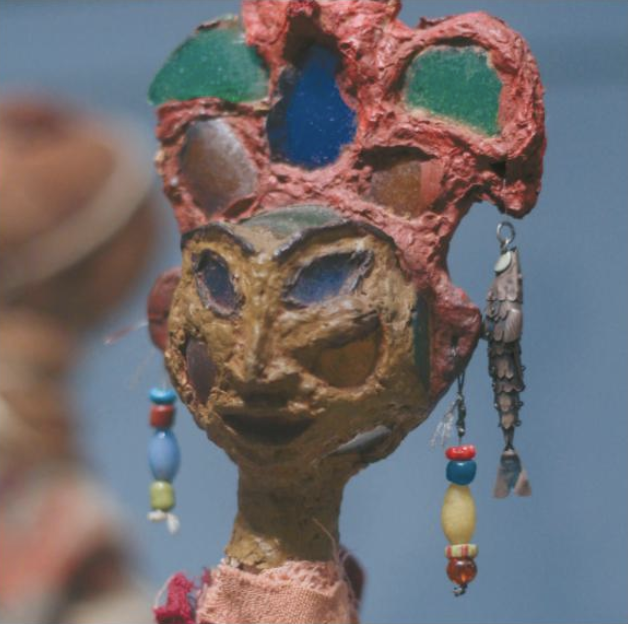By Jacob Forbes, Staff Writer
For any USM student who has yet to visit the Portland Museum of Art (PMA) this year, there is a current exhibition that might just catch their eye. Painter and Poet: The Art of Ashley Bryan brings a room to life with scenes from African folktales, Harlem Renaissance Poems, American slave history and Bryan’s own exuberant imagination.
This exhibition will most likely be most people’s first introduction to Ashley Bryan, despite the fact that he is currently 95-years-old and has been living in Maine for over three decades. Not to mention that he’s a fairly well-known artist. Bryan is primarily known as an illustrator and writer of picture books and has published over 40 to date. As an artist of color working since the 1940s, he was one of the first people to publish picture books showcasing stories and cultures from African and African-American life. The PMA’s show features original art illustrations from 14 of these books, along with puppets made from Maine’s own coastal debris and early sketches from the time Bryan was serving in the army during World War Two.
The book scenes, which vary from collage, print and painting demonstrate Bryan’s genius as an illustrator. Whether it is the face of an American slave or a scene from an African proverb, Bryan’s two-dimensional scenes always pop out of the frame to welcome-in the viewer. This is, of course, what picture books aim to do, but Bryan has a special eye for design and rhythmic movement. In “Just Ahead, some children were crawling on the ground, rolling around seeds in a game of marble”, a Tempera painting on illustration board from the book The Adventures of Aku, he paints with just four colors and suggests all the action and movement in a scene of play while rendering the figures as graceful, solid and elegant in their compact gestures. Not every picture book artist could showcase their illustrations separately, but Ashley Bryan’s work can stand alone in such a way.
There is also an anthropological element to consider in many of the book pieces. A lot of the visual forms are derived from African cultures that Bryan has researched and compiled a library of. He also researched African folklore to find stories and settings that would prove amiable to his visual imagination. A painting from his book, The Night Has Ears: African Proverbs, called “If the people of the town and village are all happy, look for the chief” combines faces derived from African masks, a flat cubic-like picture field and the visual imagining of a proverb in the high-keyed colors that Bryan likes to use. His skill for visual unity in this context is unsurpassable. He can take a two-line-long proverb that does not require any other embellishment and form a visual composition that is both independently striking and enhances the text.
In his most emotionally powerful illustrations, Bryan takes historical documents from the American slave trade in the early 19th century and brings them to visual life. His book, Freedom Over Me: Eleven Slaves, Their Lives and Dreams Brought Back to Life, is an imaginative project where Bryan started with the names and ages of slaves listed in a document of sale to a single family, and according to the didactics, through his illustrations “restored the humanity that had been so cruelly stripped from these people.” The faces of the slaves he depicts are solemn but dignified, with the words of their sale cleverly pasted into the back of the portrait. When Bryan depicts their dreams, like in “Athelia Dreams”, he turns once again to color and more vibrant forms to surround the dreaming Athelia with African masks presumably from her home community across the ocean.
The bulk of the show is the work on paper from Bryan’s publications, but the puppets, meeting the visitors gaze as they walk into the room, have a distinct emotional force. As a resident of Little Cranberry Island, he collects material washed onto the shore — like sea glass, bits of cloth and wood — and forms otherworldly-looking puppets. What is so joyful and graceful in Bryan’s expressive hand as an illustrator turns lower-keyed and angular with these homemade figures. Some look like miniaturized prophets that have been wandering the world, waiting to tell you something. Ostensibly, he made these puppets to use while storytelling, but they stand alone with their own shrouds of mystery. They encourage the viewer to look into their seashell eyes and ask them a question.
The last portion of work in this show is a small collection of sketches from Bryan’s time in the Army. As a member of a segregated unit of the U.S. Army in 1943, he continued to sketch and draw from the military life going on around him. This set of sketches from the earliest examples of Bryan’s work in the show and point to other, more personal subject matter that is not found elsewhere in the room. According to the didactic printed with the material, drawing “helped him maintain his feeling of humanity during his service.”
This feeling of humanity must have been enormous in order to have survived his experience in the Normandy Invasion on Omaha Beach and his return after the war to a still segregated country. While he must have seen so much in such a long and varied life, Ashley Bryan’s career as an illustrator demonstrates his tremendous ability to rise above the mean or miserable and celebrate the fundamentally good in life: the singing, dancing, laughing and story-telling of people all around the world.

